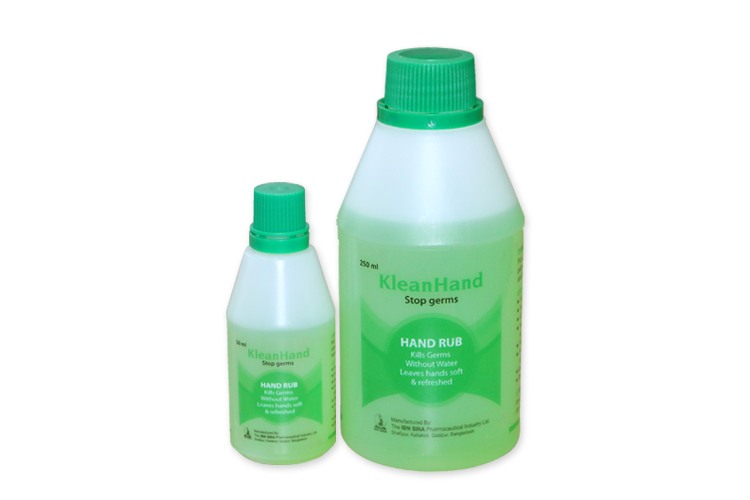
KLEANHAND
ISOPROPYL ALCOHOL BP; GLYCEROL USP & HYDROGEN PEROXIDE BP
| NAME | STRENGTH | PACK SIZE | DOSAGE FORM |
|---|---|---|---|
| KLEANHAND 50 ML | (75 ML + 1.45 ML+ 0.125ML)/1 | 50 ML | SOLUTION |
| KLEANHAND 50 ML | (75 ML + 1.45 ML+ 0.125ML)/1 | 250 ML | SOLUTION |
Each 100 ml solution contains Isopropyl Alcohol BP 75 ml, Glycerol USP 1.45 ml & Hydrogen Peroxide BP 0.125 ml (WHO recommended Hand Rub formulation).
Chlorhexidine is a very potent cationic chemoprophylactic agent that has a broad-spectrum of activity against gm+ve and gm-ve bacteria. It is both
bacteriostatic and bactericidal depending on its concentration. The bactericidal effect, which is achieved at high concentrations, is due to the binding
of the cationic to negatively charged bacterial cell walls and extramicrobial complexes. Bacteriostatic effect is achieved at low concentrations which
causes an alteration of bacterial cell osmotic equilibrium and leakage of potassium and phosphorus.
• For the disinfection of clean and intact skin.
• For pre-operative surgical hand disinfection.
• After contact with surfaces in public areas.
• Hand disinfection on the ward prior to aseptic procedures.
• After handling contaminated materials.
• For disinfection of the patients skin prior to surgery or other invasive procedures.
• Before and after caring for an ill person.
• During trael.
Pre-operative surgical hand disinfection: Dispense 5 ml of solution and spread thoroughly over both hands and forearms, rubbing vigorously. When
dry apply a further 5 ml and repeat the procedure.
Antiseptic hand disinfection on the ward: Dispense 3 ml of solution and spread thoroughly over the hands and wrists rubbing vigorously until dry.
Disinfection of patients skin: Prior to surgery apply the solution to a sterile swab and rub vigorously over the operation site for a minimum of 2
minutes. Chlorhexidine Gluconate is also used for preparation of the skin prior to invasive procedures such as venepuncture.
Chlorhexidine Gluconate is contraindicated for persons who have previously shown a hypersensitivity reaction to chlorhexidine. However, such
reactions are extremely rare.
Avoid contact with brain, meninges, middle ear or sensitive tissues and eyes. Do not inject or use in body cavities.
Irritative skin reactions can occasionally occur. Generalised allergic reactions have also been reported but are extremely rare
No untoward effects are known
Chlorhexidine is incompatible with soaps and other anionic agents. Hypochlorite bleaches may cause brown stains to develop in fabrics which have
previously been in contact with chlorhexidine solutions.
Symptoms: Pharyngeal oedema, necrotic lesions of the esophagus and elevated serum aminotransferase concentrations.
Management: Gastric lavage using milk, raw egg, gelatin or mild soap, or employ appropriate supportive measures.
Do not store above 25° C
KleanHand 50 ml: Each plastic bottle contains 50 ml solution.
KleanHand 250 ml: Each plastic bottle contains 250 ml solution.
